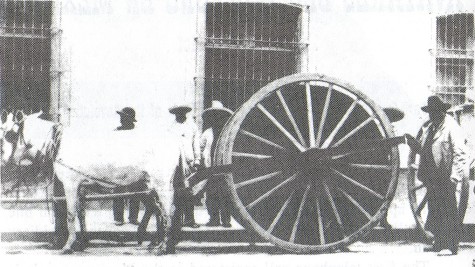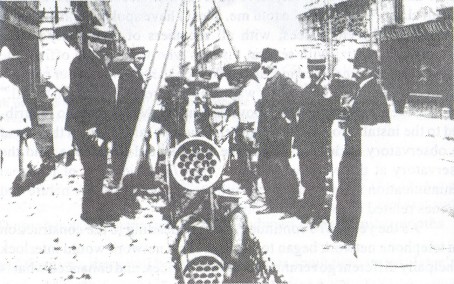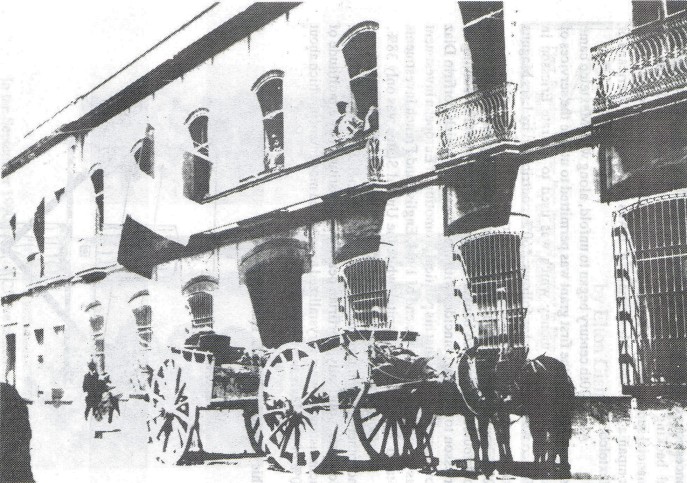Avatares Del Telefono En Mexico
by David Benedict
Reprinted from "Crown Jewels of the Wire", January 1994, page 10
Part 2: From the First Call to the Outburst of the Revolution
March 13, 1878 is recognized as the first time telephone communication was
realized between two distant points in the Valley of Mexico. Telephone
apparatus were connected to the wires of a telegraph line between Coliseo
Street, in the center of Mexico City, and the subsidiary of Tlalpan.
The first
telephone call registered in the Mexican annals is permeated by the ingredient
of personal communication. The telephone, unlike the telegraph apparatus,
permitted the voice of one person to travel along wires to the ear of another
person.
To verify the excitement of this new phenomena of communication in
Mexico, the engineer Angel Anquiano, Director of the Astronomical Observatory of
Chaputlepex, stated in 1878: "By fortune everything was directed to a
satisfactory result ... I called with the bell which was heard and answered
immediately. I proceeded to talk with Mr. Westrup, and he answered without
anymore interval than needed. I have heard with all clarity everything he told
me. Next I have spoken with each and everyone of the employees; with all members
of the family of the esteemed Mr. Ortiz; with several visitors who were in the
office: the persons who accompanied me, also talked on the telephone; our
conversation lasted about an hour and it was an hour of real satisfaction for
all."
A few weeks after the above testimony, Mr. Anquiano contributed to
the installation of the first telephone line laid between the site of the
observatory under his care at the Presidential Residence, and the observatory at
the National Palace. Thus the objectives of personal communication were
interlocked with the ones of scientific nature and the ones related to the
public administration.
As the year 1878 continued, projects leading to the
construction of a telephone network began to emerge. This network would
interlock principally different governmental branch offices, and enhanced what
is referred to as the first period of Porfirionism (named after Mexican general
Porfirio Diaz).

Dragging equipment used to transport cable reels in 1908.
The United States recognition of Porfirio Diaz as president of Mexico had
political and economical influence on Mexico throughout the end of the
19th century, and into early 20th century. The conditions established by the
United States in recognition of the Diaz government brought about feelings of
danger to Mexico, especially economically.

Placement of cable ducts for underground telephone system on the
corner of
Uruguay and Isabel La Catolila Streets in Mexico City

Front of the Telefonos Ericsson Company at 53 Victoria Street in Mexico, D.F.
Porfirionism was notably open to European investments, but the first
concessions dealing with telecommunication had gone to the technological backing
of American Bell Telephone Company; and with the financial support of the
Western Electric Company, which took the name Compania Telefonica Mexicana, S.A.
It was also known as Mericana or Mextelco.
As the 20th century began to
unfold, along with Mextelco came Ericsson. In 1904 the first grant was permitted
to utilize the services of that company. The money which was used to operate
Ericsson in Mexico was contributed as follows: *60% contributed by Lars Magnus
Ericsson, the Swedish telephone pioneer; *20% contributed by Stockholm's
Allmarina Telephone, A.B. *20% contributed by Swedish banker Marcus Wallenburg.
The coming of Ericsson to Mexico coincides with the moment in which Porfirio
Diaz government verifies that his political promotion of European investment has
been exciting. By the end of 1904, English and French investments totaled 56% of
foreign capital, while the United States was only 38%.
During the first decade
of the 20th century, Ericsson and other telephone companies continued to
increase and expand. However, politically, Porfirian peace was substituted by a
multitude of inconsistencies which crystallized to an armed movement in which
about 70% of the Mexican population died.
This concludes Part 2. Hasta luego.
| 